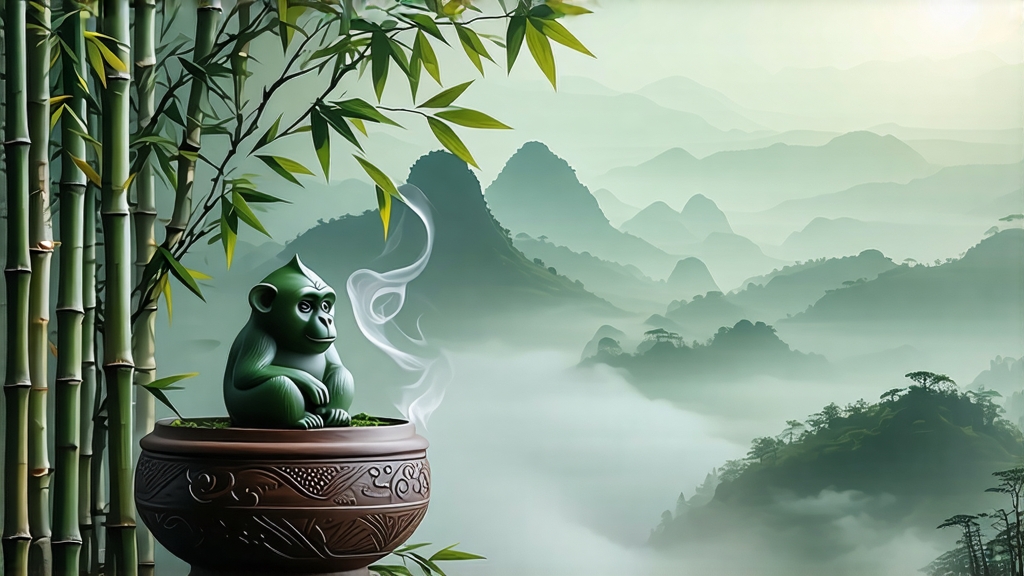
Tai Ping Hou Kui is one of China’s most visually arresting green teas: each leaf is an astonishing shade of emerald, pressed into a slender sword up to eight centimeters long, and etched with a delicate grid of faint fingerprints left by the master who shaped it. Beyond its beauty, the tea carries the cool mists of the Huangshan foothills, the laughter of monkeys that once roamed the cliffs, and four centuries of craftsmanship that turns spring buds into liquid orchid. For international drinkers accustomed to gunpowder or sencha, Hou Kui offers a gentle re-education in what green tea can taste, smell, and feel like.
Origin and legend
The name literally means “Monkey King of Tai Ping County,” a district at the northern tip of Anhui’s Huangshan range. Local chronicles first mention the tea in 1859, when farmer Wang Kui-Cheng improved upon an older variety called “Jian Cha” by selecting taller shrubs on the shaded, fog-shrouded slopes of Phoenix Ridge and Monkey Gap. A romantic story claims that Wang watched macaques pluck the tallest shoots, then copied their technique; another version says the long leaves simply resemble a monkey’s outstretched paw. Whatever the truth, the county magistrate was so impressed that he presented the tea to the Guangxu Emperor, who awarded it the status of “tribute tea” in 1900. During the 1915 Panama-Pacific International Exposition in San Francisco, Tai Ping Hou Kui won the Grand Gold Medal, sealing its global reputation long before modern specialty tea markets existed.
Terroir: why the cliffs matter
Authentic Hou Kui grows between 300 and 700 m on limestone terraces that drain quickly yet retain mineral richness. The area’s peculiar micro-climate—90 % humidity, 14 °C average temperature, and 240 foggy days per year—forces the tea bush to synthesize more amino acids and less tannin, creating the tea hallmark sweetness and low astringency. Only three tiny villages—Hou Keng, Hou Gang, and Yan Jia—supply leaves deemed genuine by local ordinance; everywhere else produces “Tai Ping Xian” tea, a respectable cousin but not the Monkey King himself.
Cultivar and plucking standards
The traditional cultivar is “Shi Da Cha,” a large-leaf landrace whose mature leaves can exceed 15 cm. Plucking occurs for barely two weeks after Qingming (early April) when buds have just unfolded into the “first leaf” stage, longer than a thumb yet still tender. Pickers climb bamboo ladders to reach the outer canopy, snapping the bud and single leaf with a downward tug that keeps the stem intact. A skilled woman gathers only 500 g of fresh leaf in a full morning; 2.3 kg of this becomes 500 g of finished tea.
Craft: the art of hand-flattening
Unlike most greens that are rolled or pan-fired into tight pellets, Hou Kui is patiently pressed. The night’s harvest is spread on bamboo trays and withered for four hours until the edges curl. Next comes “killing-green” in a charcoal-heated iron wok held at 110 °C; the tea master tosses the leaves for exactly three minutes, just enough to halt oxidation while preserving the natural springiness. The critical step follows immediately: while still hot, small handfuls are slipped between two layers of fine cotton cloth and pressed against a bamboo rack. Using only the heel of the palm, the craftsman applies rhythmic pressure, sliding from stem to tip until the leaf straightens into a flat strip. The cloth is peeled away, the leaf is fanned to cool, and the process repeats—up to four times—until the moisture drops to 15 %. Final drying occurs on low charcoal ash for an hour, then a gentle 60 °C oven for another forty minutes. No machine can replicate the subtle torque of wrist and cloth; one veteran boasts that his palm remembers every vein of every leaf.
Leaf appearance and aroma
Finished Hou Kui is olive-green with a frost of silver down the center vein; the surface shows a microscopic grid, the ghost of the cloth. When sniffed dry, it releases notes of fresh fava bean, toasted sesame, and a whisper of orchid that locals call “shan lan”—mountain orchid. The length of the leaf is not mere spectacle: the extended cell structure allows slow, even infusion, explaining why Hou Kui can steep four times without turning bitter.
Water and ware for brewing
Because the leaf is large and fragile, western-style teapots often tangle and break it; the classic method is the tall, straight “glass glass